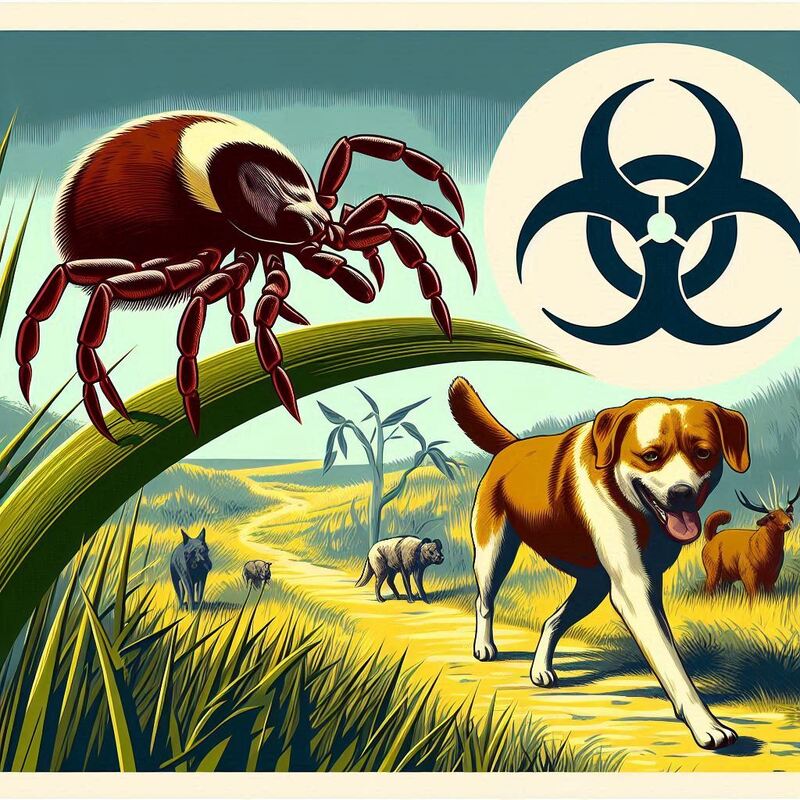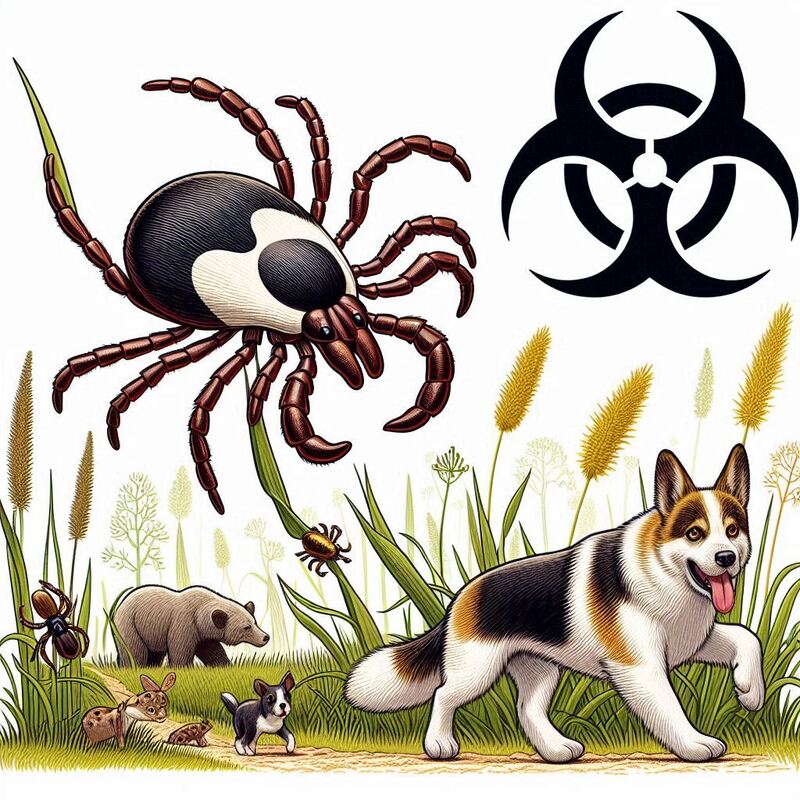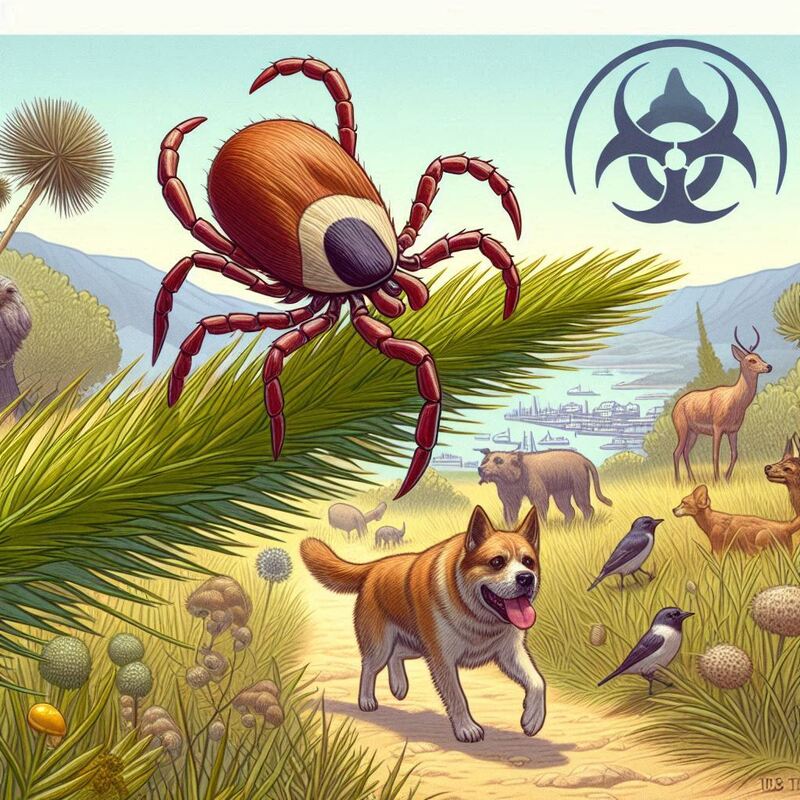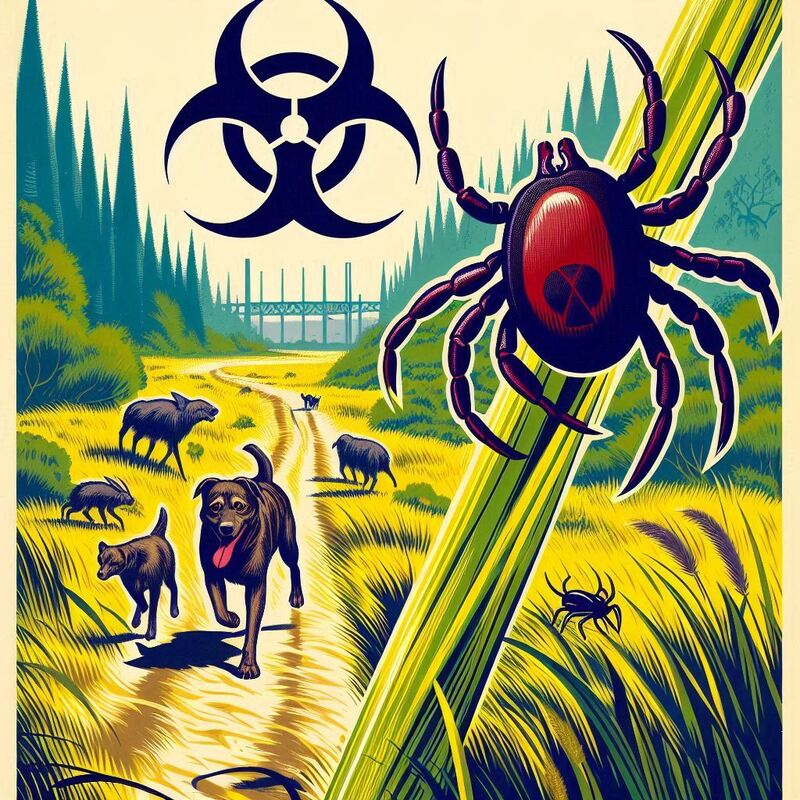protect your best friend from ticks

If you venture out into the wilderness with your dog, you’ll need to be aware of ticks and the hazards they present. Here’s some basic information on protecting you and your dog from ticks and the diseases they carry. We’ll look at the chances of contracting disease from ticks, and how those odds depend on when and where you take your dog out into California’s wilderness. Then we’ll look at several countermeasures against ticks, including how to inspect and protect your dog from them, to bring the odds into your favor.
Why You Need to Know About Ticks

Ticks will seek you out, making it far more likely to encounter them than other hazards in the wilderness. Ticks have evolved to climb up grass and shrubs. When they catch your scent, they quest with their front legs, then grab on you as you brush past. Once on you, they’ll crawl around, seeking a feeding spot. Then they’ll sink their barbed mouthparts into your skin. At best, their bites can be a painful nuisance. If you don’t find and remove them promptly, they can infect you with dangerous diseases. While many of us, both dogs and humans, have immune systems that can fend off infections from ticks, some of us are less fortunate. For some, infections contracted from ticks may develop into debilitating or life altering disease.
What Authorities like the CDC and the American Kennel Club tell us About Ticks

Statistics cited by the CDC tell us that your risk of getting sick from ticks is reasonably high. In the USA, you can find detailed information about the important species of ticks, the diseases they carry, and their geographic hot spots at the CDC website. (https://www.cdc.gov/ticks/communication-resources/press-kit.html?CDC_AAref_Val=https://www.cdc.gov/ncezid/dvbd/media/lyme-tickborne-diseases-increasing.htmlhttps://www.cdc.gov/ncezid/dvbd/media/lyme-tickborne-diseases-increasing.html).
The risk of disease may be far higher for your dog. For the hazards faced by dogs from ticks, see the The American Kennel Club’s website. (https://www.akcchf.org/canine-health/sporting-field-dogs/tick-borne-disease.html).
Putting Tick Risks in Perspective

I recommend you weigh the risks of getting sick from ticks, then act accordingly. The CDC estimates that nearly half a million Americans are diagnosed and treated for Lyme disease each year (476,000 in 2021), with Lyme disease being the leading tick borne disease. Dividing that figure by the total US population gives you a risk of about one in a thousand per year.
For dog owners and dogs who venture into the wilderness, I suspect the risk is far higher, and higher still where ticks are common. I would guess that the risk of contracting lyme disease from ticks is at least as high as suffering a heart attack. In other words, you and your dog are far more likely to contract Lyme disease from ticks than you are to win the lottery, get attacked by a white shark, or get mauled by any kind of large animal in the wilderness. But you can take several countermeasures to reverse the odds.
While lyme disease and other tick borne diseases can be treated effectively if they’re caught early, the point of this article is to provide information on how to avoid getting sick from ticks in the first place.
Let’s look at the seasons when we need to be vigilant, and the hot spots where we need to take extra precautions. We’ll focus on the tick seasons and hot spots here in California. Then we’ll consider several countermeasures we can implement to keep ourselves and our dogs safe from ticks, to stack the odds in our favor.
Two Tick Seasons in California

Roughly speaking, there are two seasons for ticks here in California, spring and winter.
In spring through early summer, you’re likely to encounter nymphs. These are very small ticks still at an early stage in their lifecycle. The risk of finding these on you or your dog begins to rise from very low levels in March, then increases through April, with the highest risk in May and early June. The risk falls off later on in June and then subsides back to very low risk in early July.
Unfortunately, your chance of getting sick from nymphs is far higher than from adult ticks. To make matters worse, the nymphs are much more difficult to find because they’re so small. You need to check carefully for nymphs when you come in from the wilderness. You also need to shower and change into clean clothes soon after returning.
I also recommend that you implement all the countermeasures listed below that you can against hard to see nymphs.
The season for adult ticks spans the winter months, beginning in late October, increasing through November, with the highest risk in December through February. Then the risk tapers off in March. During the winter, you can expect to find lots of adult ticks on yourself and your dog.
Take heart by noting that adult ticks take up to 24 hours to find a feeding spot on you or your dog. Then it takes another few hours to incur the highest risk of getting sick from them. That gives you a brief window to check for ticks and to remove them upon returning from the wilderness. It’s important to promptly check for ticks, shower, then change into clean clothes to mitigate the risk of getting sick.
Hotspots for Picking Up Ticks in California

The hotspots for ticks in California are concentrated in the High Sierras and on the coastal areas north of San Francisco. The hot spots for contracting lyme disease mirror the hotspots for ticks, again, concentrating in the High Sierras and on the coastal areas north of San Francisco. You’ll surely find ticks on yourself and your dog after hiking through the wilderness along the northern coast in Sonoma, Mendocino and Trinity counties, as well as in Mono County in the High Sierras.
In these California hot spots, the risk of contracting lyme disease in a given year is about one in twenty thousand. When you move away from these hotspots, your risk decreases down to between one in fifty thousand to one in a hundred thousand in a given year. That’s far lower than for the USA, overall, yet still significant.
In addition to checking for ticks, showering and changing clothes, learn to recognize the ecological features that favor ticks. Realize that the grasslands and chaparral of California are home to pocket gophers, ground squirrels, rabbits, elk and blacktail deer, all of whom are known hosts for ticks. These host animals and the ticks they support are abundant along the northern coast of California, particularly in the coastal prairies and chaparral.
Countermeasures Against Ticks
Countermeasures against Ticks – Inspect Your Dog
The most effective thing you can do is to inspect yourself and your dog for ticks immediately after returning home.
You’re going to have to inspect your dog’s entire body, starting with his feet and legs where he’s more likely to brush against grass and underbrush. I find ticks mostly on my dog’s face and snout, and around his eyes, probably from when he sniffs around in the thick grass on the trail side.
Countermeasures against Ticks – Inspect Yourself and Your Clothing
After inspecting your dog, inspect yourself. It helps if you have an intimate partner to check the places where you can’t. After a thorough inspection, shower and change into clean clothes.
Launder your hiking clothes and then tumble dry them at high heat. I’ve read that hot tumble drying is sufficient to kill ticks. To make sure, I would inspect your hiking clothes after laundering them.
How to Safely Remove Ticks Once they’ve Attached
Equip yourself with a pair of tweezers suitable for grasping ticks by their mouthparts.
When you act promptly, you’re more likely to find ticks before they’ve attached, and long before they’ve engorged with blood. If they haven’t yet attached, simply pick them off and dispose of them. I’ve incinerated them, flushed them down the toilet and thrown them in the trash.
If you find them already attached, then you’ll need to use a fine pointed pair of tweezers to grasp them where they’ve buried their mouth parts into the skin. Then you need to grasp them firmly by the mouth parts and pull them out with a quick tug. If the mouth parts come out intact, and the tick hasn’t yet engorged itself, then you’re probably OK.
If you’ve left any mouthparts behind, still stuck in the skin, or if the tick had already engorged itself, then it’s best to seek medical advice. In that case, put the tick in a sealed container to take in with you, in case the medical professionals need to see it.
Further Countermeasures against Ticks – Wear Protective Clothing
Ticks must crawl from where they grab on to where they find a place on your skin where they can feed. Wear light or brightly colored clothing so you can easily spot them. Also choose clothing that prevents ticks from getting to your skin. Choose long sleeve shirts with elasticated cuffs. Also wear light colored long pants, then tuck the pant legs into light colored socks.
Further Countermeasures against Ticks – Repellents
As a rule, I DO NOT spray myself or my dog with repellants, otherwise my dog might lick the chemicals off me or himself and poison himself. So I haven’t tried any of the commercially available products for repelling ticks. However, I know of four types of active ingredient, DEET, permethrin, picaridin, and a variety of plant extracts. In future, I may try one of these, provided someone comes up with a bad tasting formulation that dogs won’t lick. The same reasoning applies for not applying repellants to small children.
Further Countermeasures against Ticks – Veterinary Solutions
Every month we feed our dog a dose of NexGard. The active ingredient stays in your dog’s body for up to a month, to kill ticks and fleas, before they have a chance to transmit disease to your dog.
My Experience with Ticks in the Wilderness
I’ve experienced the abundance of ticks in the northern coastal areas of California first hand, especially the coastal regions of Sonoma and Mendocino County. You can count on finding ticks if you hike through the coastal prairie and chaparral. I’ve found them behind my knees, on the nape of my neck, on my chest and on my hip, so pretty much anywhere on the human body.
Last week I found two black legged ticks on my dog after hiking through the chaparral in the Lake Sonoma Regional Park in northwest Sonoma.
I’ve also picked up ticks hiking the countryside of Dorset, England, and in the forests of Minnesota. As far as I know I haven’t contracted any tick borne disease. Nor do I know if I’d test positive for their antigens.
Evidently, I’ve beat the odds. Otherwise, I must have a good immune system, or have done a good job of removing the ticks in a timely manner. Do what I do and be extra vigilant for ticks in their known hot spots.